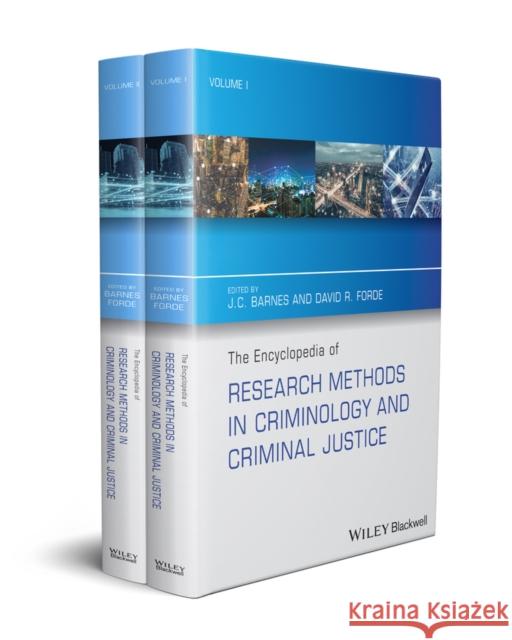The Encyclopedia of Research Methods in Criminology and Criminal Justice » książka



The Encyclopedia of Research Methods in Criminology and Criminal Justice
ISBN-13: 9781119110729 / Angielski / Twarda / 2021 / 960 str.
The Encyclopedia of Research Methods in Criminology and Criminal Justice
ISBN-13: 9781119110729 / Angielski / Twarda / 2021 / 960 str.
(netto: 1561,36 VAT: 5%)
Najniższa cena z 30 dni: 1625,99
ok. 30 dni roboczych.
Darmowa dostawa!
Volume IAbout the Editors [to come from Barnes]List of Contributors [Production to compile]Preface [to come from Barnes]Introduction [to come from MillerPart 1: Crime MeasurementBritish Social AttitudesThe Cambridge Study in Delinquent Development: New FindingsThe Campbell CollaborationConstruct ValidityCrime Mapping/Geospatial information systemsCrimeStat IVThe Dunedin Multidisciplinary Health and Development Study: Methods of a 40+ Year Longitudinal StudyFBI Supplementary Homicide ReportsForensic ScienceGeneral Social Survey (Canada) - Crime VictimizationThe General Social SurveysGeographies of CrimeLevels of Measurement in Criminology and Criminal JusticeLife history calendar methodMeasurement ReliabilityMeasurement ValidityNational Centre for Crime and Justice Statistics, AustraliaNational Incident-Based Reporting System (NIBRS)National Longitudinal Study of Adolescent to Adult Health (Add Health) in CriminologyNational Longitudinal Survey of Youth 1997Online Survey ResearchThe Pathways to Desistence Study: A Longitudinal Examination of Serious OffendersThe Project in Human Development in Chicago NeighborhoodsRochester Youth Development Study and Rochester Intergenerational StudySpace-Time Budget methodology: facilitating social ecology of crime in the Peterborough Adolescent and Young Adult Development StudyThe Study of Crime RatesUniform Crime ReportsVictim SurveysViolence and the Personal Safety Survey AustraliaWorld Health Organization Multi-Country Study on Women's Health and Domestic Violence Against WomenPart 2: TheoryThe Chicago School's Contribution to Criminological Theory and MethodsCritical Criminological MethodsDeconstruction in CriminologyEthics and Criminology and Criminal Justice: from conceptualising to conductGrounded TheoryInductive ReasoningPostmodern Methodologies in Criminology and Criminal JusticeReflexivitySituational and spatio-temporal characteristics of crimeSocial EcologyPart 3: Research DesignAnonymity and ConfidentialityCohort Studies in CriminologyConflict of InterestFixed- and Mixed-Effects Quantitative AnalysisHawthorne EffectHistory of the Hawthorne EffectHuman SubjectsImplementation EvaluationInformed ConsentInstitutional Review Board (IRB)Kansas City Preventive Patrol ExperimentLongitudinal Analysis in Criminology and Criminal JusticeObjectivityThe Opt-In Internet SurveyOutcome EvaluationPerformance Measures in Criminal Justice ProgrammingThe Philadelphia Foot Patrol ExperimentProgram EvaluationProgram FidelityQuasi-Experimental Research DesignQuestionnairesRandomized Controlled TrialRapportReplicationRisk Assessment Research: An Examination of Nomenclature, Research Questions, and Analytic StrategiesSpuriousness (Confounding)Statistical Power, P-values, and the Positive Predictive ValueTime Series DesignsTwin StudiesType I and Type II ErrorsVignettesPart 4: Qualitative MethodsBiography in criminology (source and product)Comparative and Historical AnalysisConfirmation BiasContent AnalysisCovert participant observationDiscourse analysisDocument AnalysisDrug EthnographyEdge EthnographyInterviewing, conversationalInterviewing, focus groupInterviewing, in-depthInterviewing, photo elicitationPhotovoiceQualitative Meta-synthesisQualitative Software PackagesQueer Methods in Criminology: Three Key QuestionsIndexVolume IIAbout the Editors [to come from Barnes]List of Contributors [Production to compile]Preface [to come from Barnes]Introduction [to come from Miller]Part 5: Quantitative MethodsBootstrappingCausalityConjunctive Analysis of Case ConfigurationsCost-Benefit Analysis in Criminology and Criminal JusticeThe Costs of CrimeCrime Prediction/ForecastingCrime Statistics and the MediaCross-sectional DataData ManagementEcological FallacyExperimental designs (randomized experiments)External ValidityInternal ValidityMediationMeta-AnalysisMissing Data in Criminology and Criminal JusticeOLS (Linear) RegressionPath AnalysisSecondary Data AnalysisPart 6: Research TopicsBiosocial Research MethodsCapital Punishment ResearchChallenges of Victimization Research in Criminology and Criminal JusticeConflict & radical criminologyCourts ResearchCrime scienceCriminal Career Research: An Overview of Past and Current Research MethodsCross-national ResearchDeterrence ResearchDevelopmental & Life-Course ResearchDomestic Violence ResearchEnvironmental CrimesEthnography and Grounded Theory: Tales from Prison and Parole SettingsEvidence-Based PracticeExperimental Evaluation of Rap Music AttitudesGender & Crime ResearchGenocide Research: Social and Economic AspectsGuns and Crime ResearchHomicide ResearchHuman Trafficking ResearchImmigration ResearchInternational Terrorism ResearchNeurocriminology: Brain-based perspectives on antisocial behaviorPolice legitimacyPredictive PolicingProperty CrimesQualitative Approaches to Research in Prisons and ParoleRecidivism ResearchResearch on DesistanceResearching 'active' offendersSex offendingSomatotypingVictimization and VictimologyVictims of Sex Crimes ResearchViolent OffendingThe Yale White-Collar Crime Project: A Foundation of Modern White-Collar Crime ResearchPart 7: OrganizationsAustralian Bureau of StatisticsThe Australian Criminal Intelligence CommissionAustralian Institute of Criminology: Public sector criminological researchBureau of Justice AssistanceBureau of Justice StatisticsCanadian Centre for Justice StatisticsCriminal Victimisation in Australia - National DataNational Consortium on Violence Research (NCOVR)The National Crime Victimization SurveyThe National Institute of Justice (NIJ)National SecurityOffice of Juvenile Justice and Delinquency Prevention (OJJDP)The Prison Rape Elimination Act of 2003Part 8: Statistical Methods/ProgramsBayes Statistical AnalysisConfirmatory Factor AnalysisFactor Analysis and Structural Equation ModelingGeoDa (spatial statistical program)Group-based trajectory modelingInstrumental Variables AnalysisLogistic RegressionModifiable areal unit problemMplusPropensity Score MatchingR (statistical software)Regression Discontinuity in Criminal Justice ResearchRisk Terrain Modeling (RTM)STATA: Software for Statistics and Data SoftwareStatistical significance (P values)Structural equation modelingSurvival Analysis (Regression)Virtual Reality as a Research Method in CriminologyIndex
J.C. Barnes is Professor in the School of Criminal Justice at the University of Cincinnati, USA.David R. Forde retired as Professor and Chair of Criminology and Criminal Justice at the University of North Florida, USA. Previously, he was Associate Dean of Liberal Arts and Life Sciences at the University of North Texas at Dallas, USA, Professor of Sociology, University of Alabama, and Professor of Criminology and Criminal Justice, University of Memphis.
1997-2026 DolnySlask.com Agencja Internetowa
KrainaKsiazek.PL - Księgarnia Internetowa









